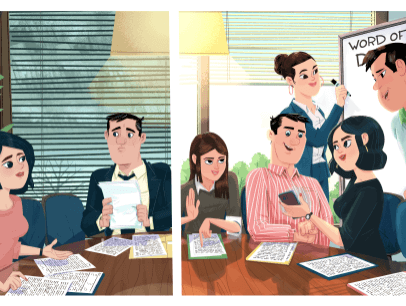In true Toastmasters fashion, Sara began her evaluation of my club coach tenure with, “Your coaching was invaluable. Everything was done extremely well.” But? “You needed to talk to individuals to learn how Toastmasters can meet their goals. The group vision starts with individual visions.”
She was right, of course.
Her comments were among the numerous peer and personal insights I gained during my year as a club coach—a year that ended with the club worse off than when I began. Of course, we often learn more from our failures than our successes. But it can be hard to face our mistakes to discover the wisdom they hold.
I believe being a club coach is one of Toastmasters’ most valuable volunteer positions—both for club improvement and for coaches hoping to hone their leadership skills. I was eager to lead, but ultimately, I was not successful. At first, I blamed the club’s members. But through self-reflection and feedback from the club and other coaches, I became aware of several subtle ways I had sabotaged myself along the way. Eventually I gained much greater insight into what it takes to connect, motivate, and rebuild a struggling club than I would have if things had gone according to plan.
My Moment of Truth
I became a club coach with a strong personal goal: to receive the required credit toward my Distinguished Toastmaster (DTM) award.
A fellow Toastmaster helped me find a club that was proactively seeking a coach due to dropping membership. The club's membership had recently dipped to 12, the eligibility point for coaching assistance. Since I had previously helped my own club recruit members to achieve Distinguished status, I felt my coaching role was a simple matter of helping the club grow by five new members to meet the Distinguished Club Program (DCP) membership requirement.
I began by holding a Moments of Truth session from the Successful Club Series to help the members reflect on their strengths, weaknesses, and goals. The club’s responses reflected a positive attitude and strong camaraderie. However, there were also signs of discord; some members complained that others didn’t contribute enough. Still, by the end of the session, we had an extensive list of ideas to help strengthen the club.
Overall, I viewed the club as healthy. They just needed to use more branded materials, dust off their guestbook, and get the word out. Within a couple of weeks, the club banner was prominently displayed, guest packets were in hand, and the club website was updated. Things were starting to click.
Then everything stopped.
I encouraged members to implement the strength-building ideas we’d identified but week after week, members failed to complete the assignments they volunteered for. Few guests attended meetings, and even fewer joined.
I pushed them to develop a Club Success Plan. To get them started, I created a simple, two-page document for members to record their aspirations, break them into bite-sized steps, and decide who would do what by when. However, weeks later the plan was unfinished, and membership was still dwindling.
This pattern repeated through the rest of my term—ambitions to get better, then no action. By the end, membership had dropped from 12 to nine. I’d read all the club coach teaching materials—what went wrong?
What Went Right
For a critical evaluation, I turned to my friend David Mauel, DTM, Past Club President and Vice President Education of Liberty Lakers Toastmasters in Liberty Lake, Washington. He worked with Vision Speaks, a club in Spokane, Washington, that chartered in 2010 and had never achieved Distinguished status. Vision Speaks is open to anyone but tends to operate differently from other clubs because most members are visually impaired. There are no written evaluations, no voting, and little reliance on a written agenda. Mauel quickly realized that he was facing a situation he was not prepared for.
I learned that the real prize of engaging a challenge is what we learn and who we become in the process.
“The biggest thing is, I went in there with a really open heart and a willingness to learn,” Mauel said. He recounted wearing a blindfold while serving as Toastmaster to experience the role the same way as the other members. “The only way to actually have empathy for someone is to walk in their shoes. And if you can’t do that if you’re not willing to take off your own,” he said.
“They were, at first, really nervous about me. They thought I was going to come in, kick in the door, change their universe,” he continued. Instead, Mauel began meetings by asking each member about their own reasons for being in the club. This established the trust and safety needed for the members to be open to change.
Mauel didn’t focus on the club’s weaknesses or obsess over DCP points. Instead, he adopted the role of cheerleader. “I was constantly reminding the club of how great they were doing and building their confidence. If you can create a culture of ‘we can do this,’ the numbers will come.”
Under Mauel’s tutelage, Vision Speaks grew from eight to 14 members and achieved Distinguished status for the first time.
No Nitpicking
When Ceitllyn Connal, DTM, District 9 Club Growth Director and member of Cascade Club in Yakima, Washington, was a club coach, she quickly realized that progress hinged on individual relationships and needs. She immediately applied that idea to her coaching efforts with the Greater Yakima Chamber Toastmasters. Nitpicking adherence to every small program detail could be counterproductive, she said.

“When you get pedantic and say, ‘We have to do this, and this, and this,’ people get frustrated. Instead, you must meet people where they are and show them the best way to achieve what they’re looking for,” she explained.
The coach earns many rewards, Connal told me. “To see the members change and take responsibility, to see the light turn on when they realize ‘this is what it’s supposed to be like,’ is incredibly rewarding.”
Reflection
After reading, reflecting, and talking to other coaches, I took my new ideas to the club I had coached to get some feedback. One member told me that while I provided good ideas, what was really missing was honest, open communication. “Leadership is about building connection and trust,” he told me. “Leadership is caring. To make changes, you need to have honest, heart-to-heart communication.”
He added that long-term members were resistant to change and that the other members, afraid to dissent, either left or remained silent. “What we needed,” he told me, “was to get everything out in the open.” Other members expressed similar sentiments.
Lessons Learned
Check your motives.
My first mistake was having a personal priority of earning education credit for my club coach participation. I lost sight of the fact that the real purpose of improving a club is not to get a ribbon but to enrich the lives of members. The purpose of earning the DTM is not to gain recognition but to grow as a person and leader. By focusing on the symbols, I missed out on the substance.
Work through conflict.
My next mistake was trying to sidestep necessary conflict. The resistance to change and simmering discord in the club I coached were the very crux of what was holding them back. By not engaging them directly, I undermined any hope of building the foundation of trust needed to create change, which doomed all my other efforts.
Working through a checklist is far easier than addressing the emotional aspects of team building, but that struggle is where growth happens and is where leadership is often needed most.
Make individual connections.
Coaching a club requires getting to know individuals and understanding how the club can help them. The club coach inspires members to care about their club and feel cared about by their club colleagues. Once members feel engaged and enthused, they will revitalize the club all on their own.
Learn and lead.
Once I reconceived my experience as a learning opportunity, valuable lessons began to materialize. First, I realized that blaming is futile, and antithetical to leadership, because it steals your power to drive change. Second, being a leader is more about perseverance than it is about always succeeding.
Most importantly, I learned that the real prize of engaging a challenge is what we learn and who we become in the process. Had success fallen in my lap, I might have my DTM by now. But I’ve come to value far more the wisdom I gained in failure.
Coaching For a Different Purpose
While the Club Coach Program is a specific, internally focused Toastmasters initiative to revive struggling clubs, the concept of coaching—helping others set and achieve personal goals—is an essential philosophy practiced by quality clubs. Whether on a formal or informal basis, Toastmasters regularly embrace the idea of mentoring and supporting their club peers.
To that end, the Effective Coaching curriculum of the Pathways learning experience helps participants polish advising and leadership skills for use in the club, the workplace, and other life settings.
For example, Savitha Setlur, DTM, who works at a Wells Fargo bank in San Leandro, California, put her Effective Coaching training to practical use by mentoring a fellow Toastmaster and bank colleague. Setlur encouraged the young woman to boost her confidence by voicing her opinions and ideas at work, and by participating in Toastmasters speech contests.
Later that year, the woman received a work promotion and reached the division level of the Toastmasters International Speech Contest. Her coach couldn’t have been happier. “I was able to help her see her own potential,” says Setlur.
As a member of three Toastmasters clubs, Setlur believes this path has improved her own capabilities as a positive communicator and leader.
“I love the way you analyze different communication and leadership styles. You figure out what yours are, which ones work best, and how you can combine different styles to be effective in certain situations,” Setlur says.
Paul Sterman is senior editor for the Toastmaster magazine.
Ryan Urie is a technical editor by profession, and a District 9 area director and former president and vice president membership of SEL Toastmasters in Pullman, Washington.
Related Articles

Club Officers
Club Coach to the Rescue

Club Experience
A Total Turnaround

Club Experience



 Previous
Previous
 Club Coach Program Overview
Club Coach Program Overview
 Previous Article
Previous Article